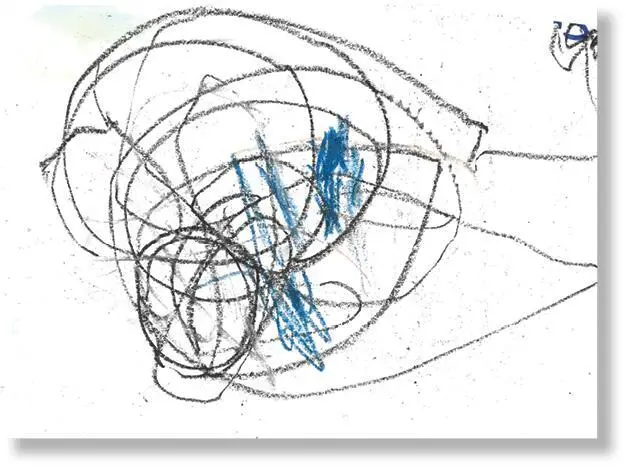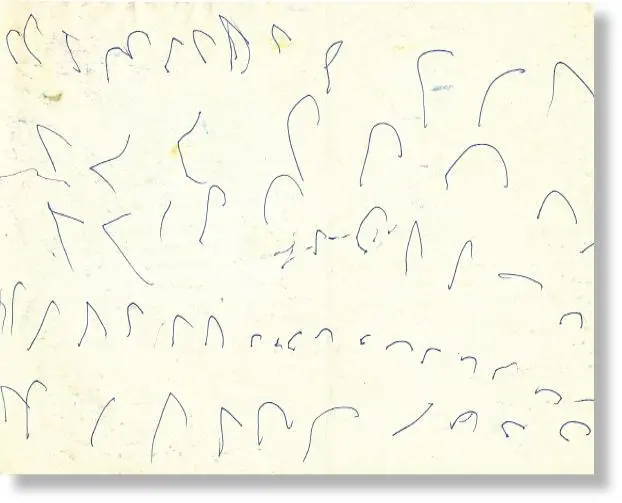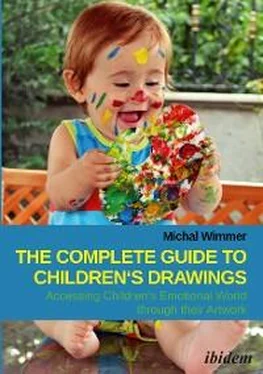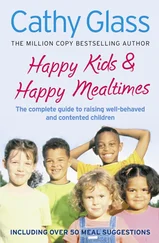Scribbling is the first step in the graphic expression process, and in that it is akin to the babbling which precedes speech among infants. Although scribbling is a preliminary experience, children who scribble soon begin to develop personal preferences and show a clear desire to produce diverse and interesting artwork. Some children start scribbling already at age one, and soon proceed to draw familiar geometric forms, followed by realistic objects (house, tree, etc.). At school age you will still find evidence of scribbling, for example beside the written lines in the notebook. Writing letters, of course, requires prior knowledge in scribbling and drawing.
During this stage, the child begins to develop his spatial orientation and ability to experience the world kinesthetically as well as through the senses. The scribbling process also provides sensory stimulation, and children at this tender age often taste their crayons. At this stage, children understand the world actively and creatively, so that they affect the information rather than receive it passively. In my opinion, older children will also do well to understand the world in this active approach. During this period, it is important to allow the child to experience a broad range of nontoxic materials such as gouache, markers, finger paints, and pastel crayons, as well as a broad range of surfaces such as rough paper, papers of various sizes and colors, wooden boards, Bristol papers and newspapers.
Some children actively seek these surfaces, ignoring the fact that the surfaces may already be written over. It is also important for children to experience a wide variety of kneading materials: dough and other foodstuffs, modeling clay, etc. to stimulate their senses.
At this stage, the edges of the surface are not absolute boundaries for the child, who tends to “stray” to nearby surfaces. When the child first starts to draw, he does it accidentally and admires the product. His fascination and that of others around him challenge him to continue exploring this dimension. However, only when you begin identifying recurring trends in the drawing will you be able to start talking about deliberate drawing that represents conscious intervention by the child.
Drawing is fundamentally a muscular activity and as such, it attests to the child’s temperament and adjustment to his environment.
When the child draws, he is required to balance between movements away from the body (executed by relieving pressure, as you can see in Figure 23) and movements towards the body (executed by contraction and applying pressure, as you can see in Figure 22). Internalizing this pressure is evidence to the maturation of certain brain and nervous system mechanisms and helps the child refine his equilibrium system. By way of drawing, the child enhances his control over various bodily organs and adjusts his bodily posture to the type of drawing he wishes to produce.

Figure 1-19:Example of a scribble from the circular sub-stage
A student of creative education, Victor Lowenfeld (1947) saw drawings as reflecting the child’s view of reality. His studies led to the identification of fours scribbling sub-stages: (1) Disordered or lacking control over motor activity; (2) Longitudinal or controlled repetitions of motions; (3) Circular – further exploring of control motions demonstrating the ability to produce more complex forms; and (4) Naming, where the child tells stories about the scribble, gives it a title and demonstrates symbolic condition.
In other words, according to Lowenfeld the child acquires skills as he practices drawing, wherein lies the importance of recurring drawing elements. Recurrence is also stressed by Rhoda Kellogg (1969), who compiled a list of 20 basic scribbles that represent the foundations of graphic development. Kellogg proceeded to identify 17 compositions which suggest certain regularity in the scribble’s location on the page.
Kellogg argued that scribbling has nothing to do with the child’s present psychological development, but that it is evidence of collective hereditary memory.
Namely, the various scribbling variations are not acquired from the environment but inherent to the human organism from birth, indicating the drawer’s uniform sequence of graphic development and nothing more.
Kellogg’s studies are considered controversial. Many of her critics argued that the basic patterns she identified appear in only some of the scribbles in her record, so that they cannot be considered indicative of a universal graphic development sequence.
Likewise, while Kellogg argued that the motive for scribbling is an innate urge to build and to create, that has more to do with the collective unconscious than with the desire to depict external objects, her critics (e.g. Matthews 1988) presented a large number of drawings by children who accompanied their artwork by statements of their desire to document reality, notwithstanding the jumble of lines on the page. Personally, I believe children are affected by a primary urge to create while at the same time being affected by the need to communicate with the environment by way of borrowing existing concepts (archetypes such as the recurring house pattern).

Figure 1-21:Letter-like symbols
The scribbling stage is also when mandalas begin to appear in children’s drawings. These are rounded forms, from which lines extend in various directions, or forms crossed by lines). By drawing mandalas, children acquire the ability to later draw suns with rays, or tadpole figures (human figures without torsos).
Between the ages of 1½ and 3½ you can also find scribbles reminiscent of letters, which are called «letter-like symbols».Such shapes cannot be found in all drawings, but when they are found they do seem to resemble handwriting, including careful attention to lines and spaces.
Such writing attests to the development of fine motor skills, as well as to enhanced brain-eye-hand coordination and spatial orientation. It does not, however, suggest the child is ready to learn how to read and write. Rather this is a passing fad which will return, in some children, around age 4. At this age, many children start writing their names and often use mirror writing, suggestive of internal development processes related to hemispheric dominance.
In art therapy, scribbling is considered a nonthreatening and even soothing technique in that it is completely purposeless. Scribbling is not oriented towards a final outcome and not committed to produce a pretty and accurate picture, but promotes an experiential process free of any rules or inhibitions (Kramer 1975).
Another phenomenon typical of this stage is drawing on walls. Almost every parent is familiar with this situation, facing the masterpiece and asking himself, why on the wall of all places?
The very act of drawing provides sensory stimulation and enjoyment, and since children at the scribbling stage have only begun internalizing the idea of boundaries, they see absolutely nothing wrong with testing their skills and expressing their talents on surfaces deemed unconventional by adults, like walls.
Drawing on walls is just part of a long sequence of attempts by children to test their abilities. The desire to move objects and “produce artistic output” is expressed in their playing at the sandbox, in the bathtub or on the dinner table – when the child grabs a fruit and realizes he is capable of taking it to his mouth. Children also leave their mark artistically, as if marking a territory, as if saying, “Look at me! Only I could draw that!”
Читать дальше














